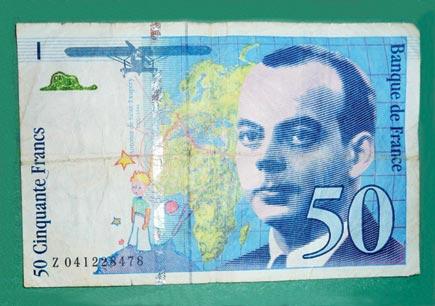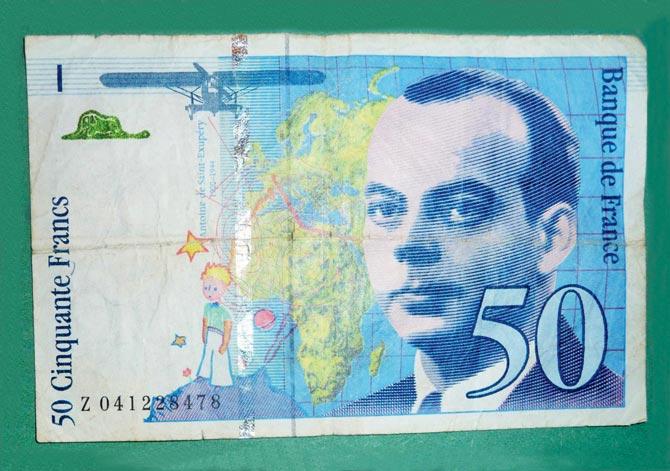I’ve spent the last few days in bank queues from 6.30 am, and have managed to enter the bank at about 10 am, hoping to withdraw a measly part of my own savings


The former 50 franc note featured aviator and author Antoine de Saint-Exupery
 I’ve spent the last few days in bank queues from 6.30 am, and have managed to enter the bank at about 10 am, hoping to withdraw a measly part of my own savings. Frankly, I’d rarely met that part of the morning; it was a revelation. Sweepers still swept away the remains of Diwali akashbuttis, morning milk arrived in a gleaming steel tank on wheels and reached the shop through a dirty, green irrigation plastic pipe. I’m working on a book and it’s a fantastic undisturbed three hours for ideas and jottings, as it’s too early for anyone to call you. Finally, after an eternal wait, I managed to get a few of those R2,000 notes.
I’ve spent the last few days in bank queues from 6.30 am, and have managed to enter the bank at about 10 am, hoping to withdraw a measly part of my own savings. Frankly, I’d rarely met that part of the morning; it was a revelation. Sweepers still swept away the remains of Diwali akashbuttis, morning milk arrived in a gleaming steel tank on wheels and reached the shop through a dirty, green irrigation plastic pipe. I’m working on a book and it’s a fantastic undisturbed three hours for ideas and jottings, as it’s too early for anyone to call you. Finally, after an eternal wait, I managed to get a few of those R2,000 notes.
ADVERTISEMENT
The newly-minted R2,000 bank note is a supremely awful purply-pink shade that aspires to be a jambul (black plum) sorbet, but fails. Worse, it belongs to the Pavbhaji School of Design: shove in everything you can lay your hands on, mash it all up, clanging noisily, add a strong dash of colour, topped with a slab of Amul butter — like a drawing of Gandhiji — hoping it makes the gloop unimpeachable. Each side of the note is a hideous clutter of 30-plus design elements, no less. On one side, poor Gandhiji seems to be wearing half a shadowy brown wig. Help! On the other, there’s Mangalyaan orbiting a dirty red Mars, Gandhiji’s chashma with Swachch Bharat written over the lenses so as to block his vision, and a row of elephants, peacocks and lotuses — all in widely contrasting styles. The designer must have been teaching his child numbers, for I counted R2,000 written seven times on one side in English and Hindi alone, with more hidden in the watermark. Poor Mangalyaan looks like a primitive bhatti the Flintstones might have used, with a flip-out lid at the back and a trio of footmats in the front, and wheels going askew.
Let’s see what other nations’ currencies look like. The French 50 franc note, sadly overtaken by the euro, is my hands-down fave, a thing of joy and wonder. A lovely blue note, it featured French aviator and author Antoine de Saint-Exupery, and a drawing of his most famous creation, the Little Prince, standing on his home planet, Asteroid B-612. It also has de Saint-Exupery’s drawing of “an elephant inside a boa constrictor,” which to adults looks merely like a hat. According to Peter Symes, there is a “second drawing, on the inside of the boa constrictor digesting an elephant, printed on the bank notes in colour-shifting ink,” and a hidden drawing of a ram, printed in white ink on white paper. What charming mischief, as its design elegantly draws from literature, philosophy and fable.
The US dollar is a King Bore, design-wise: primarily black and white, it has drawings of worthies like Abraham Lincoln or George Washington and the US eagle motif. Ho-hum. The euro has ekdum efficient motifs, mostly engineering and architectural marvels: Roman aqueducts, bridges, Gothic windows, Greek pediments or grand arches with statuary, all with Europe’s circle of stars. Hmm. The Australian dollar, coated with polymer, is more adventurous. Its 20 dollar note even has a fun, transparent plastic flower that you can actually see through. Its 50 dollar note celebrates different kinds of minorities — one features David Unaipon, indigenous Australian author and inventor, and Edith Cowan, first woman member of Australian Parliament.
And India? Will we be forever stuck, design-wise, with the ubiquitous Gandhiji on all our R2,000, 1,000, 500, 100, 50, 20 and 10 notes? Or can we also imagine putting, say, Satyajit Ray and his adorable Apu on our currency, and having the panache, like the French, to celebrate, literature, philosophy and innocence? Because, as de Saint-Exupery wrote, “What is essential is invisible to the eye.”
Meenakshi Shedde is South Asia Consultant to the Berlin Film Festival, award-winning critic, curator to festivals worldwide and journalist. Reach her at meenakshishedde@gmail.com.
 Subscribe today by clicking the link and stay updated with the latest news!" Click here!
Subscribe today by clicking the link and stay updated with the latest news!" Click here!







